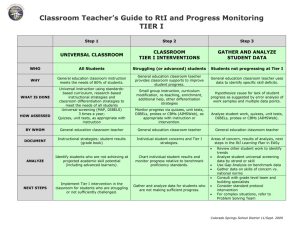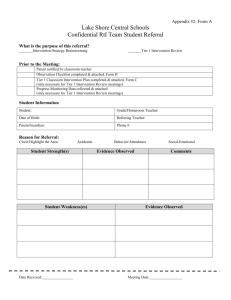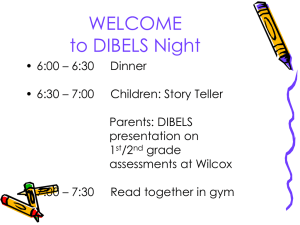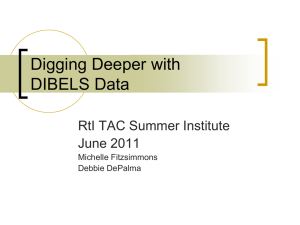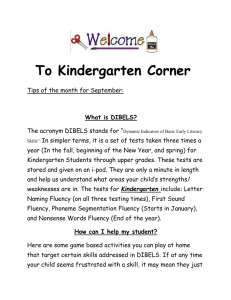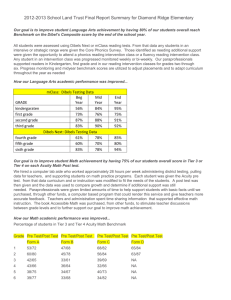Intervention Training #1
advertisement
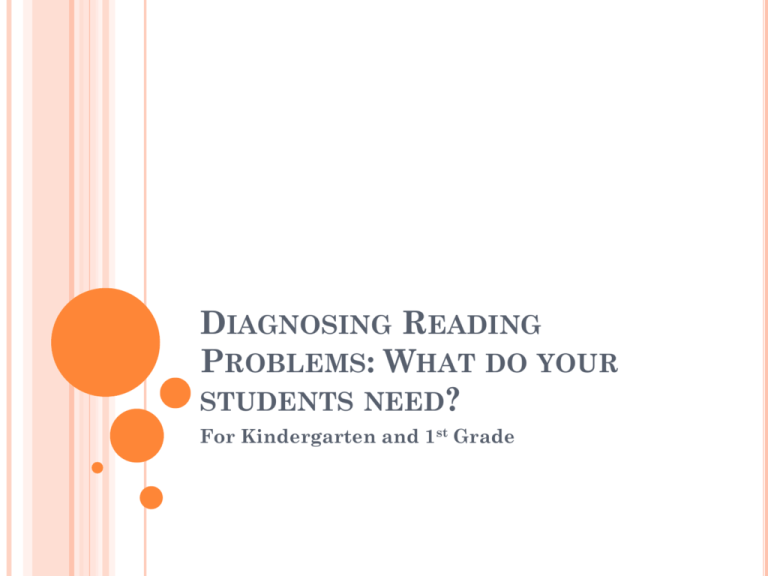
DIAGNOSING READING PROBLEMS: WHAT DO YOUR STUDENTS NEED? For Kindergarten and 1st Grade TRAINING OVERVIEW RTI model of reading Taking DIBELS to the next level (using DIBELS as diagnostic tool) Error analysis for PSF, NWF, and ORF Grouping students for instructional decisions Next steps LEARNING TARGETS I say say what RTI means. I can use Dibels to find students that need extra instruction. I know what my next steps are for administering an intervention model in my classroom or building. RTI MODEL RTI RTI is not a program, it’s a philosophy/tool/framework RTI stands for Response To Intervention (sometimes Response to Instruction) In the past, we’ve had a “wait to fail” model. RTI is Preventative Model RTI CORE PRINCIPLES Use all available resources to teach all students – minimize silos Universal screening for prevention instead of waiting for intervention Multi-tier model of service delivery Explicit & systematic instruction Data based decisions using a problem solving or standard protocol approach Monitor student progress frequently Multiple assessment measures Monitoring implementation fidelity 3 TIERED MODEL Tier 3: Students who need intensive or individualized support. 5% Tier 2: Students who do not make progress in Tier 1 are provided with more intensive interventions 15% Tier 1: All students receive high quality instruction as well as regular progress monitoring 80% 3 TIERED MODEL Tier 3: Tier 2: Tier 1: District Adopted Curriculum (Read Well or Reading Street) 90 minutes at Instructional Level Scientifically Based Practices Data Driven Decision Making (Progress Monitoring) Differentiated Instruction 3 TIERED MODEL Tier 3: Tier 2: Pull aside Added practice outside the 90 minutes 20-30 minute additional instruction Data Driven Decision Making (progress monitoring) Scientifically based practices District Adopted Intervention Materials Use data to make decisions Tier 1: 3 TIERED MODEL Tier 3: Replacement “Core” Scientifically based practices Data Driven Decision Making (progress monitoring) Tier 2: Tier 1: RTI In an RTI/Intervention model, students do not stay in intervention groups forever. Every 4-6 weeks, use assessment to re-group. Kids receive the services they need. The nature of the intervention changes at each tier, becoming more rigorous as the student moves through the tiers Students move up and down the tiers depending on need WHY WE’RE REALLY DOING THIS Students speak to us through their data. It is up to us to hear what they are telling us and do something about it! USING DIBELS TO HELP DETERMINE STUDENT NEEDS WHAT ARE THE SUBTESTS? Dibels Indicators 5 Essential Components Letter Naming Fluency (LNF) Tied to Alphabetic Principle Initial Sound Fluency (ISF) Phonemic Awareness Phoneme Segmentation Fluency (PSF) Phonemic Awareness Nonsense Word Fluency (NWF) Phonics Oral Reading Fluency (ORF) Fluency Retell Fluency Comprehension** WHAT DO THE SCORES MEAN? Reading fluently with comprehension is the ultimate goal. DIBELS uses early skills (LNF, PSF, NWF, ORF) to predict how likely it is a child will be a strong reader later. Students must achieve or exceed goals on time to be on track for successful reading. WHAT DO THE SCORES MEAN? When you see a DIBELS report, you will see a raw score for each student as well as: Intensive At Risk Deficit Strategic Some Risk Emerging Benchmark Low Risk Established A child’s score will determine if they are Intensive, Strategic, or Benchmark. DIBELS MARKINGS IN TACOMA DIBELS Scoring Cheat Sheet Timing Hesitation Prompt Discontinue Scoring Tips* Letter Naming Fluency (LNF) Start timing after saying “Begin” and stop at 1 minute. (]) After 3 seconds, provide the correct letter name and point to the next letter and say, “What letter?” (prompt may be repeated) “Remember to tell me the letter name and not the sound.” (One time only) No letters correct in the first row (10 letters). Draw a line through a skipped row and do not count in scoring. Initial Sound Fluency (ISF) Start timing after question and stop when student responds. After 5 seconds, “Remember to tell score as 0 and present me the picture that next question. begins with the sound ___.” Score of 0 on first 5 questions. Record number of seconds and calculate the fluency score. Phoneme Segmentation Fluency Start timing when After 3 seconds, first word is provide next word. presented and stop at 1 minute. (]) (PSF) Nonsense Word Fluency (NWF) Start timing after saying “Begin” and stop at 1 minute. (]) After 3 seconds, score the sound/word as incorrect and provide the correct sound/word. If necessary, point to the next sound/word, and say, “What sound/word?”* Depends on whether student is reading “sound by sound” or “word by word”. DIBELS Oral Start timing after After 3 seconds, provide the next Reading Fluency student says first word and stop at 1 word. (DORF) minute. (]) “Remember to tell me the sounds in the word.” Marking t L s u 0 1 No correct sound If student repeats the /t/ /r/ /i/ /k/ 4/4 segments in first 5 entire word with no /k/ /a/ /t/ 2/3 words. segmentation, circle the word and do not give any /t/ /r/ /i/ /k/ 0/3 points. No correct sounds in first 5 words. No words read correct in first row. Draw a line through a skipped row and do not count in scoring. Three passages administered and median (middle) score recorded. tob 3/3 tob 3/3 tob 2/3 It was a live fish. 4/5 tt It was a live fish. 4/5 THE IMPORTANCE OF ACCURACY IN OLDER GRADES Accuracy is a piece/ one aspect used to determine instructional decisions. Why do we look at accuracy? Research and examples DIBELS ORF scores at the end of 1st grade. (Benchmark is 40 wcpm.) Billy reads 35 wcpm with no errors. Sally reads 52 wcpm with 8 errors. Which student is more likely to have strong comprehension? Which student is more likely to have decoding issues? WHO NEEDS HELP IN LNF? Looking at the class list report. LETTER NAMING FLUENCY: DIAGNOSIS Our Turn Your Turn Where are the greatest areas of need for this student? WHO NEEDS MORE HELP IN PSF? Looking at the class list report. PHONEME SEGMENTATION: DIAGNOSIS DIBELS Phoneme Segmentation – Error Analysis (1st Grade – Fall, Winter, Spring STUDENT NAME 1. 2. 3. 4. 5. 6. 7. 8. 9. 10. 11. 12. 13. Testing Period F W S KINDER – Winter, Spring) VOWEL sound error INITIAL sound error ENDING sound error BLENDS Other error patterns PHONEME SEGMENTATION: DIAGNOSIS Our Turn Your Turn Where are the greatest areas of need for this student? WHO NEEDS MORE HELP IN NWF? Looking at the class list report. NONSENSE WORD FLUENCY: DIAGNOSIS DIBELS Nonsense Word Fluency – Error Analysis (1st Grade - Fall, Winter, Spring KINDER - Winter, Spring STUDENT NAME 1. 2. 3. 4. 5. 6. 7. 8. 9. 10. 11. 12. 13. VOWEL sound error 2nd Grade – Fall) INITIAL sound error ENDING sound error Testing Period F W S REVERSALS Other error patterns # read as words NONSENSE WORD FLUENCY: DIAGNOSIS Our Turn Your Turn Where are the greatest areas of need for this student? USING READ WELL ASSESSMENT TO DETERMINE STUDENT NEED WHO NEEDS HELP IN READ WELL? Determine which students are not passing their assessments. DIAGNOSING ORF ISSUES Diagnosing Fluency Issues Using DIBELS ORF St udent Nam e:_____ ____ ____ ___ F W S St udent Grade Level:___ ___ Accuracy Rate Median (Middle) score ______________ Median score’s accuracy _________ *Accuracy = words read correctly/total words read Mult isyllabic? Ending Sound Error? Middle Sound Error? Init ial Sound Error? Error Ef f ect Meaning? Passage Word High Word as Read Assess. # Frequenc y Word? Chart ing Errors: Not e t he assessm ent # w her e t he st udent m isr ead a w or d. Wr it e t he w or d “as r ead” and t he cor r ect passage w or d. Place an “x ” in each block t hat applies t o t he err or . Tot als: Developed by Mart ha Teigen f or WA Reading First , Oct ober 2005 (adapt ed f rom work of Haggar, Dimino, Windmueller, Project Plus) Adapt ed by Kelly Pruit t , Tacoma School Dist rict ORF: DIAGNOSIS Our Turn Your Turn Where are the greatest areas of need for this student? GROUPING STUDENTS BASED ON NEED RATE AND ACCURACY If a student has been placed in the At Risk category for LNF, but has named all letters correctly, should they be placed in the same group as a child who has named all letters on the page, but only scored 3 correct? If a child scores 23 (benchmark is 24) on NWF in 1st grade and made no mistakes, should she be placed in the same group as a child who is emerging, but scored 14 with 60% accuracy? Consider both rate and accuracy when determining groups and recommendations GROUPING STUDENTS USING DIBEL’S SCORES: MODIFIED PILE PROTOCOL Look at the class list report we’ve been working with: 1. Highlight/Identify students who are some risk or at risk for Letter Naming Fluency. 2. Highlight/Identify students who scored deficit or emerging for PSF. 3. Error analysis for LNF Error analysis for PSF Highlight/Identify students, who were not identified in the LNF or PSF group, who scored deficit or emerging for NWF. Error analysis for NWF GROUPING CONSIDERATIONS FOR TIER 2 IN PRIMARY GRADES The best instruction is 1st instruction. Intervention CAN happen in the 90 minutes. LNF difficulties can be addressed in the whole group reading instruction. Small pull asides or quick interventions with groups of students can occur in the 90 minute block. GROUP SHARING Get into a mixed group In your group discuss the following questions (post answers and be ready to share): 1. How do you incorporate intervention into your initial (1st tier) instruction now? 2. If you use walk to read at your building, share how it works with the group. 3. If you don’t walk to read, how do you address differing student needs? HOW TO GROUP STUDENTS AND DETERMINE INSTRUCTIONAL RECOMMENDATIONS FOR INTERVENTIONS? Look at what the data tells us about similarities and difficulties to form groups and develop instructional recommendations Form groups based on needs of students and staff resources FORMING GROUPS: A SCENARIO Mythical School’s 1st grade team wants to start an intervention group. They have 2 classroom teachers ready to start. Ms. Sally’s class has 8 students who need short vowel decoding work (based on the Dibels Error Analysis). Mr. Jones’ class has 7 students who need help with PSF and sight words. They decide to spend 25 minutes before lunch every day “walking to intervention”. Mr. Jones takes the 15 students who need decoding and PSF help and forms a small group. Ms. Sally takes her remaining students and Mr. Jones’ students and works on deeper comprehension and vocabulary skills using the Read Well lessons she never gets to. FORMING GROUPS: A SCENARIO Storybook School’s Kindergarten team consists of one classroom teacher, Ms. Blue. Ms. Blue’s class has 15 students who need help with their letters (based on Dibels), 5 students who need work on Phoneme Segmentation and the rest of her students are at benchmark. Ms. Blue asks one of her student’s grandma (who is a retired school bus driver) to come into class for 20 minutes every day. Grandma Green takes the 5 students who need PSF work and plays phonemic awareness games with them in the back of the room. Ms. Blue decides since so many of her students need letter naming work, she is going to incorporate a letter naming template into her 90 minute instruction. She wants to make sure she makes it to all the letters by January. GROUP PROBLEM SOLVING Gather with your grade level team from your building. Discuss the following: What human-resources are available at your building to provide interventions? (Think of all of them: parents, volunteers, high school older brothers, grandparents, community members, lunch ladies, office staff with a “free” 20 minutes a day) What small bits of time do you have as a team if you wanted to “walk to intervention”? What small bits of time do you have if you need to do intervention on your own? What are some possible scenarios you can develop for your team? What needs to happen next at _________ in order for you to implement an RTI model that includes systematic Tier 2 instruction? INTERVENTION NEXT STEPS NOW THAT YOU HAVE SOME KNOWLEDGE, USE IT! Look at student’s scores and DIBELs booklets Use diagnostic tools for those who need it. Determine which areas your students need the most assistance. Vocabulary Makiing Meaning Strategies ELI Strategies and Reading Street ELI Strategies Reading Street Vocab Book Fluency Making Meaning strategies Skill Builders ELI Strategies and Reading Street Phonics 6 minute solution Templates Phonics for Reading ELI Strategies and Reading Street Syllaboards Phonemic Awareness SIPPS Road to the Code Templates ELI Strategies Road to the Code Phonemic Awareness in young Children SIPPS Beginning Template Reading Intervention Materials Training Matrix All Staff: Diagnosing and identifying Reading Problems Using the Diagnostic Tool/I've Dibeled Now What? Comprehension A FINAL THOUGHT… “You can have the results you say you want, or you can have the reasons why you can’t have them. But you can’t have both. Reasons or results. You get to choose.” -Susan Scott Fierce Conversations EXIT SLIP Please Reflect on the learning targets for tonight: I say what RTI means. I can use Dibels to find students that need extra instruction. I know what my next steps are for administering an intervention model in my classroom or building.
